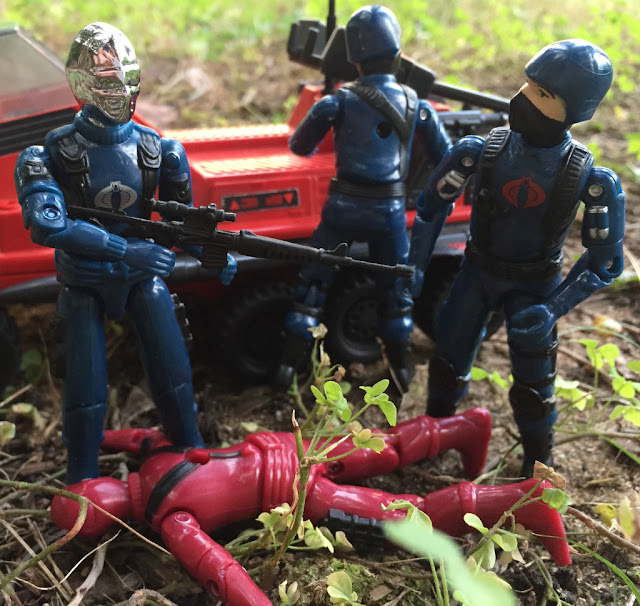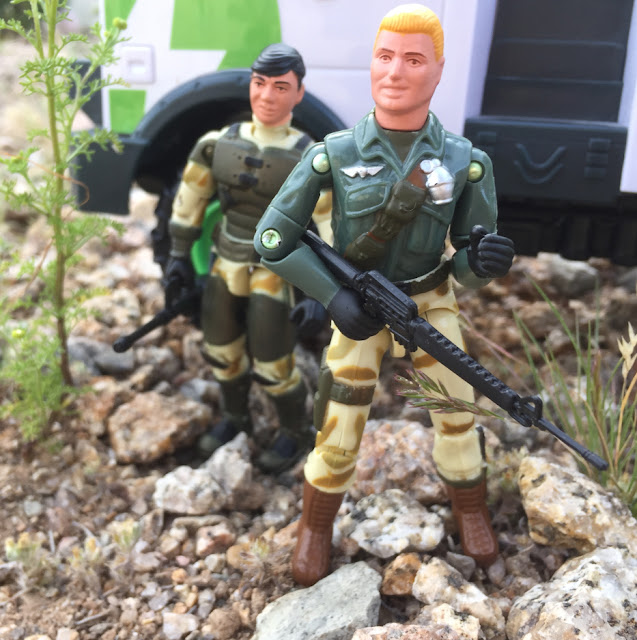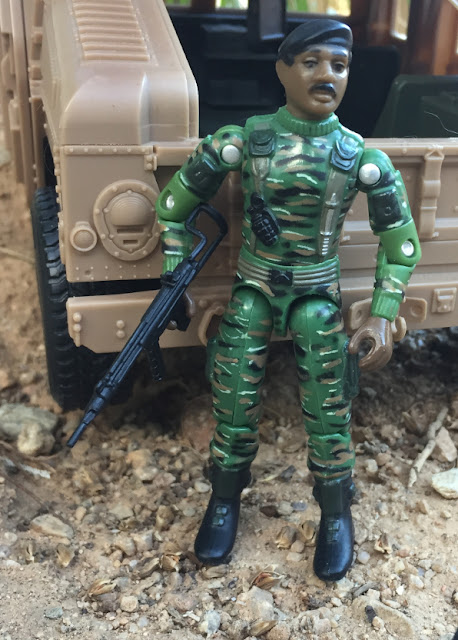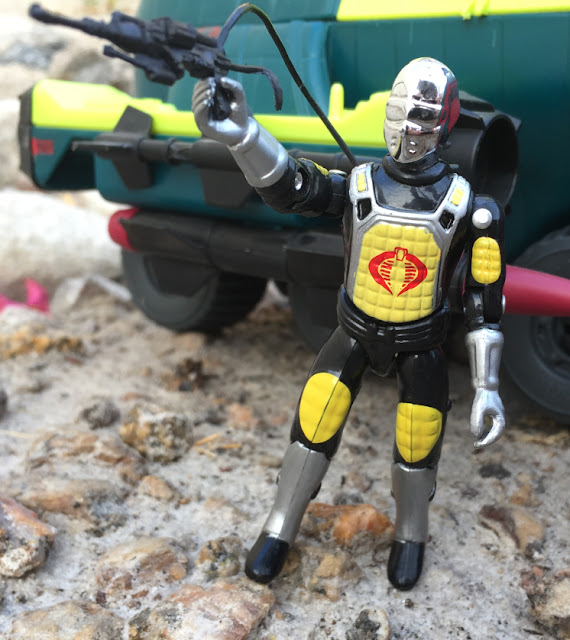There was a time in the Joe world where information was scarce. We now know that the reason for this is that many collectors like to hoard information and keep it to themselves. This gives them "credibility" in the Joe community. The side effect of this is that bad information can quickly take on a lift of it's own. And, in some cases, left unchecked, the bad information is perpetuated by an "official" release. In the case of the Brazilian Cobra De Aco, bad information lead to a perception that the figure was among the rarest in the world. Time has proven that false. But, the damage was done as the figure remains far pricier than many of his harder to find contemporaries. Fortunately, the Black Major dropped a version of the De Aco about a decade ago so that every collector would have a shot at the character.
So, as I held this figure for the first time, something dawned on me. One of the reasons that the De Aco is so out of place is because of his color scheme. Yellow isn't, traditionally, a Cobra color. So, he's very distinctive when viewed through the lens of early Joe releases. However, the Cobra De Aco was likely released in 1986. If you look at the 1986 American releases, there is a figure that is very similar to De Aco's color scheme: the 1986 BAT. It seems an unlikely coincidence that Brazil would release a figure with a chrome head and a color scheme to match the American android in the same year as that figure's debut. Is the De Aco based on early renditions of the BAT? Or, was the color scheme adopted in an attempt to have a release in Brazil that matched the American BAT?
International exclusive characters remain one of the great mysteries of the Joe world. How did exclusives like the De Aco, Manleh, or even the European Mutt come to be? Seeing the De Aco's similarity to the BAT, though, makes me think that the foreign companies had access to either abandoned Hasbro designs or to successful color palettes that were being introduced simultaneously in the U.S. We have gotten a lot of great stories about the origins of the American line from some of the Joe creators. But, we have not heard much of any collaboration with foreign Joe licensees (assuming such communication even occurred).
Harsh reality time. The Cobra De Aco isn't a good figure. (The Cobra Mortal isn't, either.) Were this an American release, collectors would deride it. Were this an American release from the 1990's, the figure would be a joke. But, because the De Aco was an exotic oddity, a mystique built up around it. That aura was augmented with the 30th Anniversary card set released in 1994. Here, the De Aco made his most famous debut with the tagline that "no mint samples have been identified thus far". This made many collectors think the figure simply didn't exist. But, the explosion of the internet proved that wrong. By 1998, it was well known that the De Aco was very obtainable from Brazil and that another figure featuring a chrome Snake Eyes, the Cobra Mortal from Argentina, was both rarer and more interesting than the De Aco.
If you were around online Joedome in the late 1990's, the De Aco vs. Mortal was a common thread where people would argue vehemently about the rarity of one of the other. As photos were much harder to take, scan, post and send in those days, there was little proof. But, as digital cameras and broadband permeated the collector base, it was quickly shown that the De Aco was, really, a common Brazilian release that was readily available. The popularity of the figure and the aura built around it in the years prior, though, kept the price high. But, as the economic crisis in Argentina in the early 2000's brought a decent amount of the rare 2nd series Plastirama figures (the 6 (SIX!!!!) figure wave that included the Mortal) to the market, it was proven out that the Argentine figures were rarer, more desirable and would forever be more expensive than the once mighty De Aco.
For me, this figure is useless, though. Sure, he has visual appear. But, he's straight arm. I don't collect straight arm Joes. I don't collect them because the simple addition of swivel arm battle grip was the difference between G.I. Joe being a few month fad in 1982 and being a nearly 40 year long obsession. I don't own Joes for collectibility. I own them for the toys they are. And, straight arm figures are bad toys.
All of this leads to the baffling question as to why this figure features straight arms. At the time, many customers clamored for a swivel arm version. But, for the sake of authenticity, those calls were resisted. And, we got a straight arm figure. As repaints of the figure became available (some of them amazing updates that are way better than the original....) they began to include alternate heads. Modeled on the Gas Mask Trooper, these heads allowed the De Aco bodies to be used for troop builders. Had they come with an alternate pair of swivel arms instead, these figures would have sold out far more quickly than they did. With the straight arms, the various repaints of this mold were available for years...often at or below the original prices. It's only been since 2018 that they have dried up. Red Laser also make a version of the De Aco. It was meant to have swivel arms to fill the gap left by this Black Major original. However, a factory mix up resulted in Red Laser's figure also having straight arms. Today, there is no version of the De Aco available with swivel arms. There are Cobra Mortals with swivel arms. But, no De Acos. It remains a huge hole in the collecting world. But, as we've had two homages released with straight arms, it doesn't seem likely that a swivel arm De Aco will ever be a thing.
And, that's a shame. I love having new characters in pre-1985 construction to mesh with my early Cobras. The early Black Major Cobra Invasors and Mortals are excellent ways to augment the sparse early Cobra field leaders. Having De Aco would further expand their ranks in excellent ways. And, I suppose, standing this figure among Cobra hierarchy would work. But, that's not where I find value in figures. I enjoy posing them, photographing them and letting them appear as toys. With a straight arm De Aco, I can't do that. So, the character has died on the vine and has no relevance to me.
Collectors still think that 2007 was the heyday of modern collecting. Some will even argue that it's happening right now, in 2020 with the Classified figures. But, the real pinnacle of the online Joe collecting era began in 2001, expanded through 2003 and didn't really die off until after the 2005 G.I. Joe convention. As Joe started to become something that had collecting buzz around it, dealers took notice. Quickly, they jumped into the Joe world, thinking it was going to be Star Wars or Hot Wheels. And, for a short time, it was. Back then, you could still find large collections at garage sales, thrift stores and even comic shops for paltry sums. So, dealers could get stock. But, those trying to get ill-informed toy show prices for figures soon learned the perils of the cheap Joe collectors. Nonetheless, some dealers tried to buy their way into the market by leading with rare figures. But, as these dealers knew little about Joe, they'd make gaffes along the way.
Starting in late 2001, I and other collectors started getting emails from various toy dealers. They were almost always peddling Cobra De Aco figures. They'd repeat the no known mint versions line in an attempt to sell the figures. One major toy dealer (he's still around, today) reached out to try to sell me a De Aco for $1,000. I told him, at best, his figure was a $200 example. He dropped the no mint figures line. At which point, I sent him a link to Ebay listings with five or six De Acos, all sold for less than my quoted price. The dealer never contacted me again and the De Aco sat on his website for many, many years. Many of my friends reported the same. Along with these dealer inquiries, we'd get unsolicited offers from Brazilian Joe sellers all the time. Funnily enough, they'd lead with the De Aco. But, then, you could get '90's era Brazilian exclusives (many MOC) from them for absurdly cheap prices. It was through one such interaction that I acquired several of my now expensive Brazilian figures for peanuts.
You would think that the guys who fancy themselves the "Guardians of Joe" would have been up in arms about this De Aco. They weren't. Why? Simple, none of them own enough De Acos to worry about the impact these Black Major and Red Laser figures would have on the market. Besides, it's been proven again and again that factory customs tend to increase the values of the original figures upon which they are based. But, all the anti-Black Major guys were silent on this figure. Only Starduster upset them. That should tell you all you need to know about their true intentions. The upside is that a lot of collectors got a chance to own both a cheap version of De Aco, but also a version that could be used for photos, dios and other activities. That's always good for the community. And, this figure has given the De Aco a chance to grow out of his status as a rare oddity and into something that has some value to the Joe world. If he only had swivel arms....
Fun fact, the mold used for this De Aco is the same chest mold used on the Sightline figure. The De Aco has an extraordinarily large backpack hole. This feature carried over to Sightline and is why Sightline can't wear his backpack without some modifications to make the backpack peg bigger. This larger hole is also the obvious tell on the factory custom De Acos over those made by Estrela. Aside from that, the yellow is different, the Cobra logos are a dead giveaway, there's a tag on the figure's leg and the entire mold feels very different from an Estrela figure. In short, there's no mistaking this figure for an original.
20 years ago, a real Cobra De Aco would have cost you $300. Now, a real Cobra De Aco will still run you around $300. It's a pretty steep fall from grace for a figure going from one of the most expensive Joes in the world to not even the most expensive figure from Brazil. If you want a Factory Custom version, you can get them in the $20-$25 range. Most of the figures that are currently available, though, are the Red Laser's Army version of the De Aco instead of this older Black Major figure. I have not owned a Red Laser version, so I can't speak to the differences between the two. But, the later releases will keep prices of the Black Major version in the same ballpark. If you don't mind straight arms, that's not a terrible price to get something like De Aco. But, for me, the limiting construction also limits his value and it's unlikely you'll see this figure appear in many photos going forward.





























